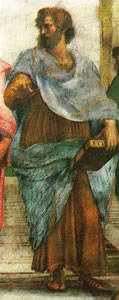In the beginning of the sixteenth century in Rome, while
Michelangelo was painting the Sistine ceiling, across the
way Raphael was hard at work on his Vatican frescos, the most
famous of which is his enormous School of Athens.
In the center of this mural, the young painter placed Plato
and Aristotle, side by side, juxtaposed in eternal philosophical
opposition.

Detail of Plato from
Raphael, School of Athens |
As the art historian William Fleming reminds us, "The
book Plato holds in his hands is his Timaeus, and he
points skyward to indicate his idealistic worldview. Aristotle
carries his Ethics and indicates by his earthward gesture
his greater concern with the real world."
Plato dreamed of a golden heaven on earth, a utopian paradise
satiated in justice and righteousness. In The Republic,
he laid out his plans for just such a world, even providing
the societal laws that would allow it to exist.
In Book X, he reasoned through one such law. The poets, he
argued, must be banished: they can only provide a representation
of the true thing; this representation is a lie because it
is not wholly and truly the thing itself; art, once it is
removed from truth, can only appeal to the base instincts
in humanity.
For Plato, only that which pulled us toward moral perfection
could be allowed to exist in his Edenic city-state.

Detail of Aristotle from
Raphael, School of Athens |
Aristotle, less metaphysical, was more interested in examining
the real world, the world of Athena, goddess of reason - as
brazen as that real world may be.
This month artists from around the country gathered in New
York City for the Hip-Hop Summit. Their arguments were so strikingly familiar that I
was forced to acknowledge this simple truth: some of our political
tensions will never, and I mean never, find resolution.
Senator Joseph Lieberman, for example, would like for the
industry to regulate itself, to censor its lyrics, to stop
marketing to the youth. He, like Plato, would only allow that
which is edifying and purifying to float through our airwaves.
Louis Farrakhan, on the other hand, argues that rappers merely
illustrate the truth of their lives. "What society wants
to do with the young people," Farrakhan preaches, "is
to break the mirror rather than take a look at it and clean
itself up."
Likewise resisting Lieberman's arguments, rapper Redman states,
"The way I look at it, preach and rap don't make no money.
Negativity lives in rap. That's what it's built on. That's
what money circulates and generates from. Negativity. That's
all I see."
Farrakhan and Redman are closer to the Aristotelian view:
we have to examine the world as it is not just dream about
how we would like it to be.
So here in the month of June, just as New York begins to
swelter with summer heat, the members of congress, of leadership
organizations, of the hip-hop industry can gather for their
summit, but pardon me if I am a bit skeptical that any resolution
can come out of an argument as old as the history of western
thought itself.
June 2001
|



